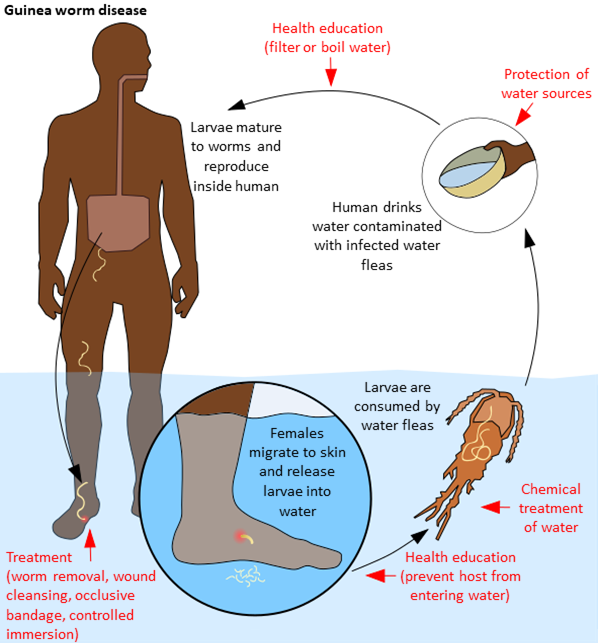Guinea worm is a disease caused by the worm Dracunculus medinensis and is therefore also referred to as dracunculiasis. It is a vector-borne disease that is transmitted to humans via small water fleas. Guinea worm disease is found in South Asia and Northern Sub-Saharan Africa only.
The disease is rarely deadly but can cause extreme discomfort. Painful blisters form on the skin, which are prone to bacterial infections. The disease can also lead to joint injuries and damage of inner organs.1
Humans become infected by drinking water contaminated with the worm’s larvae.2 Only when the worm surfaces at their human host’s knee area, ten to fourteen months after ingesting the larvae, is a diagnosis possible.3
Thanks to improved water sanitation, Guinea worm cases were recorded in only two countries in 2017: Chad and Ethiopia.
The worm’s life cycle progresses from humans to water fleas (copepods) and back to humans and is visualized in the illustration. In alarvae form, the worm enters the human host via contaminated drinking water. In the human gut, male and female worms mate. Subsequently, the female worms grow to a length of up to 120 cm and migrate to the lower part of the human leg to surface.
When the wound is washed, the worm releases numerous larvae into the water. These find a new water fleas host and another person who drinks contaminated water gets infected again.
Transmission of Guinea worm disease (in black) and the ways to prevent it (in red)4

The ways to prevent the spread of Guinea worm is highlighted in the illustration above in a red font. As is the case with any vector-born disease, eradication can be achieved by interrupting the transmission from the vector to the human or the other way round. In the case of Guinea worm, specifically, the worm depends on both water fleas and humans for survival so that there is more than one means against the disease. Sources of drinking water can be decontaminated and health education campaigns can inform about filtering drinking water and the appropriate disposal of removed worms.
Making water safe for drinking can be achieved by filtration; not washing wounds in public waters reduces larval spread. Public health education teaching people how to prevent the spread of Guinea worm has proven very successful.5
The WHO has been working to eliminate Guinea worm since 1981. Recently, the original target to eradicate the Guinea worm by 2020 has been moved to 2030. While the number of human infections remains low, just 28 in 2018, a recent detection of high rates of worm infection in dog population in Chad suggests that the Guinea worm may still be transmitted in the region.6
WHO provides global data on the number of Guinea worm cases is available from 1986 onwards and is shown in the world map. The limited geographic spread of the disease becomes especially clear when clicking on play at the bottom of the chart – it was only ever endemic in South Asia, Yemen and Northern Sub-Saharan Africa.
As it takes 10 to 14 months for the worm to emerge after infection, the last case will necessarily occur a year after the spread of the disease has been interrupted. To be certified Guinea worm free, a country needs to report zero cases for three consecutive years. After this period a country can apply for certification by the International Certification Team of the WHO to verify that transmission has indeed been interrupted. The last country to be certified was Kenya in 2017. In 2018, 28 cases of Guinea worm have been reported, these where in Angola (1 case), Chad (17 cases) and South Sudan (10 cases). 7